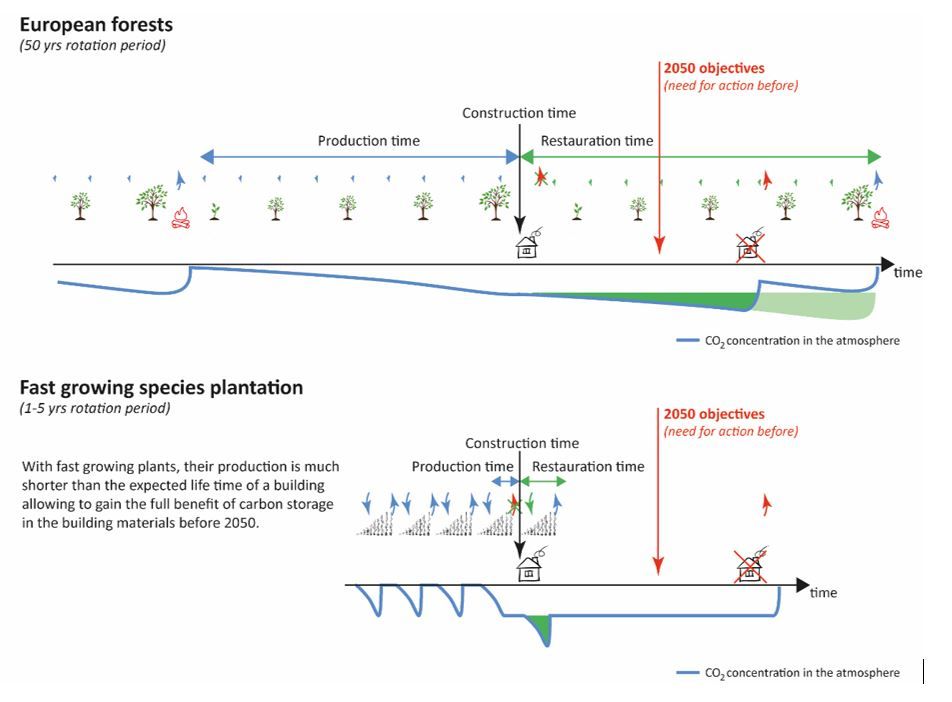Carbon neutral or climate neutral ?

Carbon neutral or climate neutral? The question may seem incongruous, as the term carbon neutrality has entered the technical language used by policy-makers. For example, in August 2019, the Swiss Federal Council decided to aim for climate neutrality by 2050. The French government, on the other hand, launched in January 2020 a battle plan to achieve carbon neutrality by 2050. Are we playing with words or is there a big gap between these two ambitions?
Lets’ start with a few definitions. Carbon refers to the constituent atom of all living things on Earth. The Earth is made mainly of Silica and those who live on it are made of Carbon. This carbon is also present in the atmosphere in the form of carbon dioxide or methane. These gases are responsible for the greenhouse effect, which is generally beneficial to maintain a mild temperature on Earth (without greenhouse gases, it would be as cold as on the Moon), but its excess leads to the climate disruption we are currently witnessing (e.g. storms, fires, floods, heat waves…). All scientists and the vast majority of governments agree that it is absolutely necessary to reduce the quantity of greenhouse gases (GHG) in the atmosphere by 2050 to avoid a climate catastrophe.
CO2 is the main GHG and a simplification is often made between the quantity of GHGs and the quantity of CO2 in the atmosphere. Similarly, since a CO2 molecule contains one carbon atom, a quantity of carbon is referred to as a quantity of CO2. Finally, to finish this overview of molecules and their origins, it is important to remember that atmospheric CO2 can come from the combustion of fossil organic matter. That is to say, matter that made up the living beings on Earth hundreds of millions of years ago and that has been fossilized, for example, in the gigantic coal deposits of the Carboniferous age. It is the combustion, due to human activities, of this coal (and oil) of fossil origin which is responsible for today's climate disruption. The CO2 contained in the atmosphere can also come from the biological activities of living organisms, it is called biogenic CO2. It is absorbed each year during plant growth and re-emitted at the end of the plant's life, or from the leaf to return to the atmosphere.
Carbon accounting
Carbon neutrality stabilizes the amount of CO2 in the atmosphere, which seems to be equivalent to achieving climate neutrality, where the aim is to stabilize the greenhouse effect. However, the human contribution to the greenhouse effect is mainly due to fossil CO2 emissions, whereas the carbon contribution will include both fossil and biogenic CO2. Current calculations to calculate the environmental impact of construction products (EPDs) and their contribution to climate change consider only fossil GHG emissions. This contribution is expressed in CO2equivalent. However, the development of carbon accounting encourages the consideration of biogenic and fossil carbon.
Between carbon and climate, the difference comes from the system boundaries and leads to uncertainty about the strategy to achieve system stability. Indeed, to be climate neutral, it is possible either to do nothing (which limits our activities) or to compensate all the positive emissions we have had. In buildings, these "negative emissions", this storage, relies most of the time on bio-based materials. For instance, let’s consider a building with a timber structure and hybrid timber-concrete floors. A quantification of the amount of carbon in the building will show that a large amount of carbon is stored in the building and that the production of the concrete floors has emitted a significant amount of CO2 into the atmosphere. In order to get a zero sum, it is sufficient that the quantity of wood contains a quantity of carbon equivalent to the CO2 emitted during the production of the concrete. 1m3 of wood contains about one ton of CO2, 1 m3 of concrete emits about 300 kg of CO2. If the building contains less than 3 m3 of concrete for each m3 of wood, it could then be called zero carbon building.
On the importance of time...
On the other hand, a climate quantification will show that the production of one m3 of concrete released about 300 kg of fossil CO2 into the atmosphere at the time of production of the material, but that the storage of the carbon contained in the wood took place well before the time of construction, when the tree was growing in the forest. The transformation of a tree originally present in the forest into a building did not remove CO2 from the atmosphere. Thus, when the house is built, the result is that the building contributes to climate change due to the CO2 emissions of the concrete. Then, according to the assumptions of forest management, we can imagine that when we cut down a tree, we replant another one. This allows, over time, a capture of atmospheric CO2, so that once this tree is mature, we have the same "carbon balance" as in the previous calculation. But the balance is not climate neutral, since throughout the tree's growth, there was an excess of CO2 from the emissions of the concrete occurring at the time of construction. In order to be climate neutral, fossil CO2 emissions must be immediately offset by storing carbon in bio-based materials. This is only possible with fast-growing plants such as straw, hemp, grass or bamboo. With these plants, carbon neutrality is close to climate neutrality, since the plants are already regenerated in the year following construction, so that a removal of CO2 from the atmosphere due to construction can be accounted for. This is illustrated in the attached diagram.
...and storage period
However, the scientific community does not agree on a common calculation method. To establish a relationship between the amount of biogenic carbon contained in a material and its contribution to global warming, Canadian teams have, for instance, established relationships by taking into account the storage time in the building and the rotation period of the plant in the Nature[1].
For a plant that would remain in the building for 50 years and needs 60 years to grow, each kg of biogenic CO2 captured by the plant during its growth will have an effect equivalent to -0.16 kgCO2 in terms of its contribution to climate change. On the other hand, if the rotation period is not 60 years but one year and the residence time in the building is the same, this same kg of biogenic CO2 will contribute -0.4 kg CO2 equivalent to climate change.
With this calculation method, a climate-neutral building will therefore have to contain between 2 and 5 times more biogenic material (depending on the type of materials chosen and their residence time in the building) than if the calculation were made solely on a carbon-neutral basis.
A bad indicator is worse than no indicator at all
The French Minister for Cities and Housing, Julien Denormandie, told the French press agency that all new public buildings will have to be built with at least 50% wood or biobased materials. Is this measure part of a carbon neutrality strategy? Does the government believe it can store carbon in buildings and thus reduce the effect of climate change? Or is it just an announcement and the minister is well aware of the simplifications made?
Sometimes a bad indicator is worse than no indicator at all said Donella Meadows[2], pioneer of Sustainable Development and author of "Limits to Growth" in the 1970s. The confusion between carbon neutrality and climate neutrality is leading us down a path of reducing GHG emissions, but certainly not offsetting them. This pushes us to believe that we are neutral for the planet while in reality the act of building will still have a negative effects on the climate and will only be compensated in the long term. However, it is crucial to eliminate fossil CO2 emissions within the next 20 years and without counting on a compensation through biogenic CO2 storage, which will only become effective in 30 years' time.
To do this, we need to look at the resources available and how quickly we can engage the transition. Fast-growing bio-based materials provide an opportunity to rapidly expand production and thus effectively reduce the amount of CO2 in the atmosphere. Slower growing bio-based materials such as wood have lower GHG emissions than conventional materials. However, they have already stored CO2 in the forest and can therefore only be considered as an additional carbon sink to a lesser extent. The next 20 years are crucial. A bad indicator can lock us in a wrong path where we could not have time to get out of before 2050. So let's try to produce climate-neutral buildings - which is entirely possible - without being lured by the ease of carbon-neutral building.

Figure: CO2 dynamic and the exchanges between natural and built environment (From FIBRA Award book, Museo editions)
[1] Guest, G., Cherubini, F., Strømman, A.H., 2013. Global Warming Potential of Carbon Dioxide Emissions from Biomass Stored in the Anthroposphere and Used for Bioenergy at End of Life. J. Ind. Ecol. 17, 20–30.
[2] Meadows, D., 1998. Indicators and Information Systems for Sustainable, A Report to the Balaton Group.
An article by Guillaume Habert, Professor of sustainable construction, ETH Zurich, Switzerland
This article was first published on Construction21 France in a special dossier on biosourced material.



